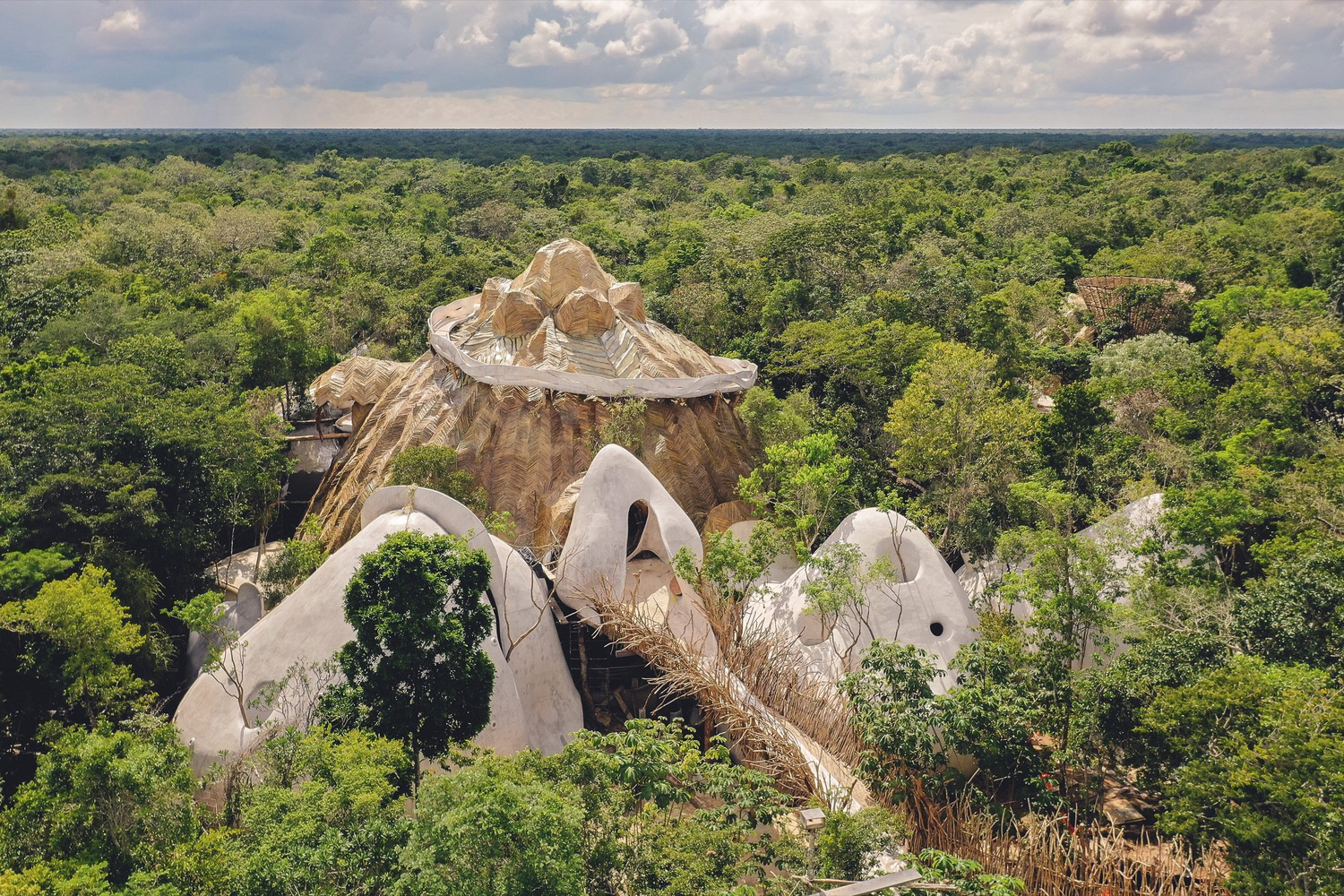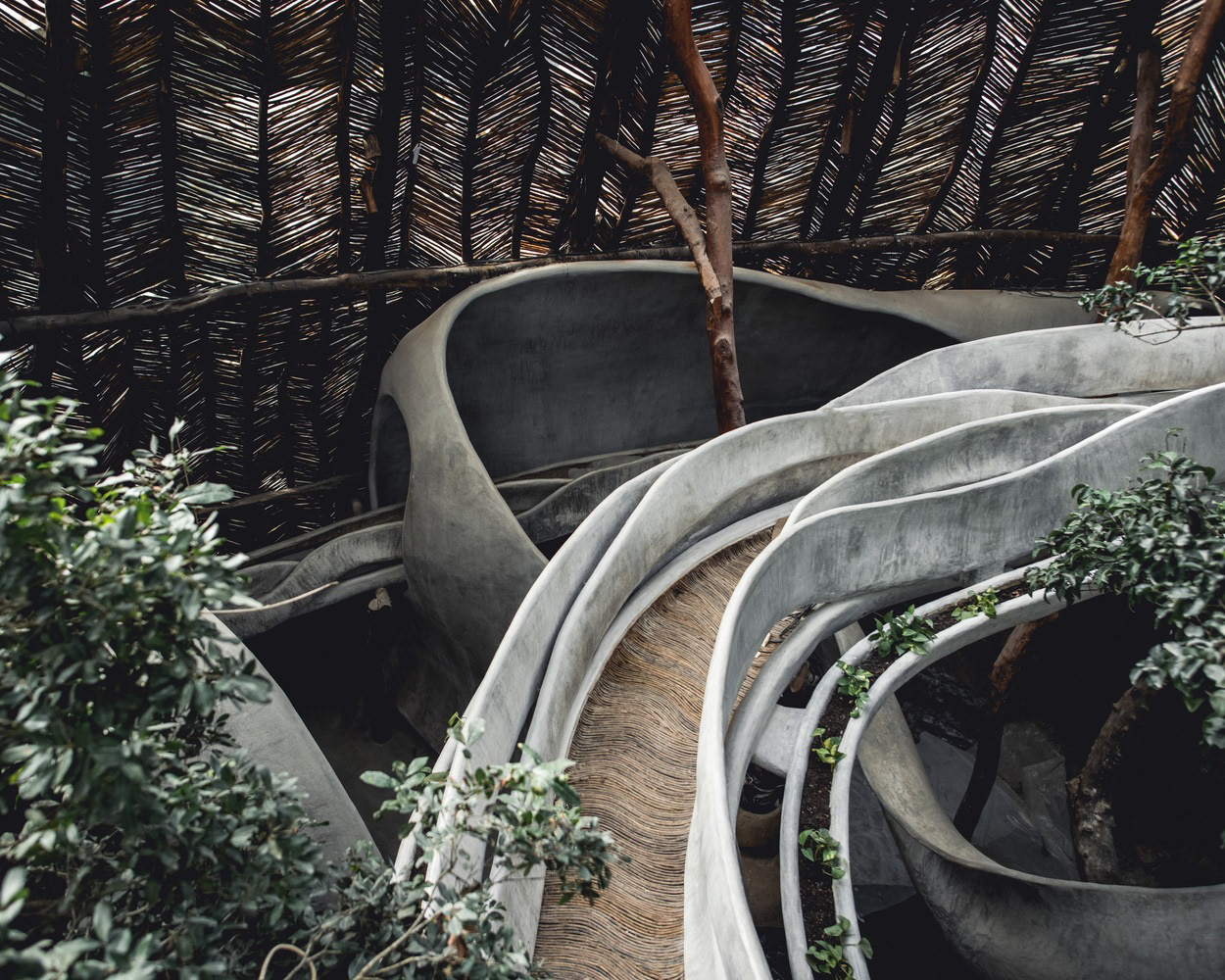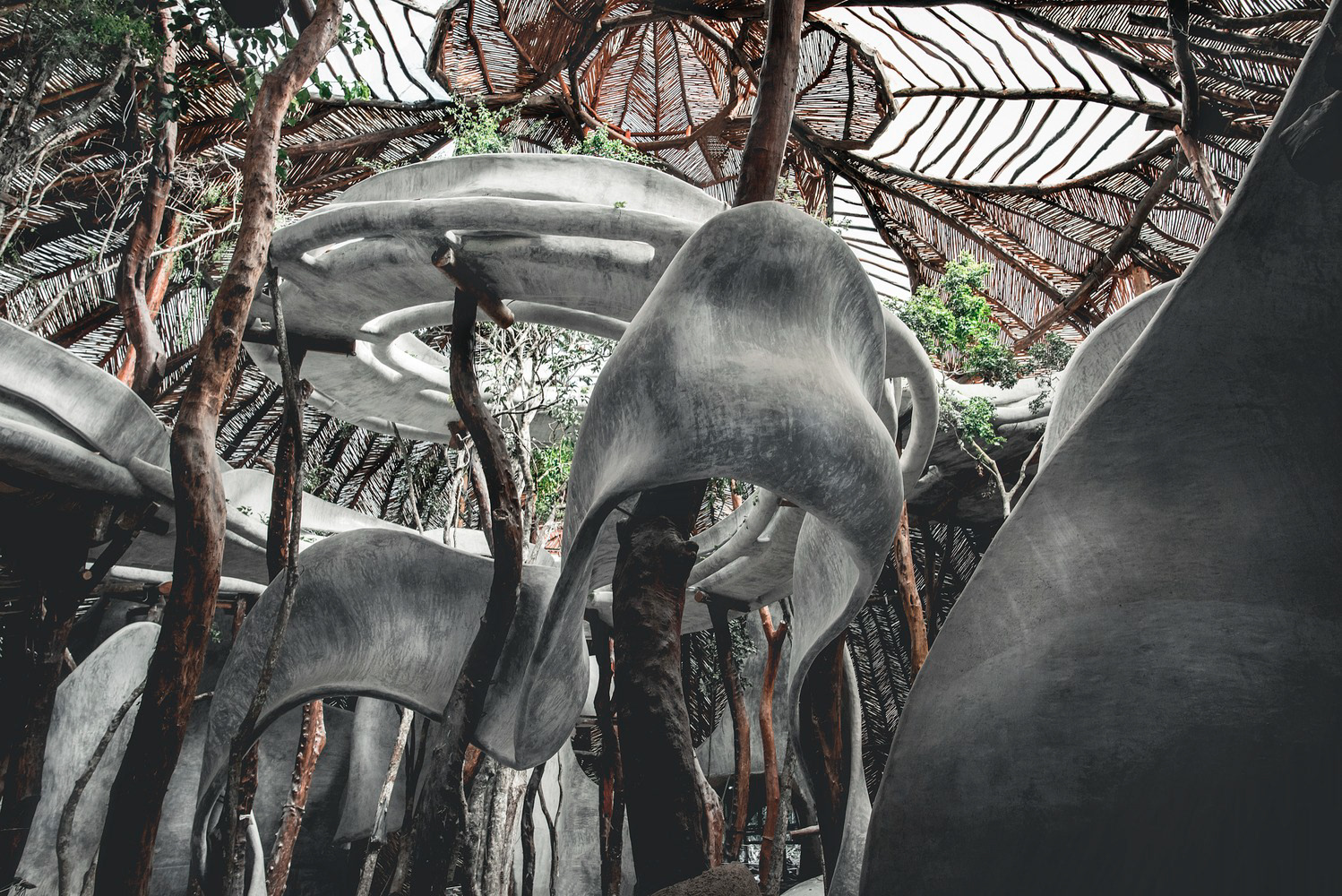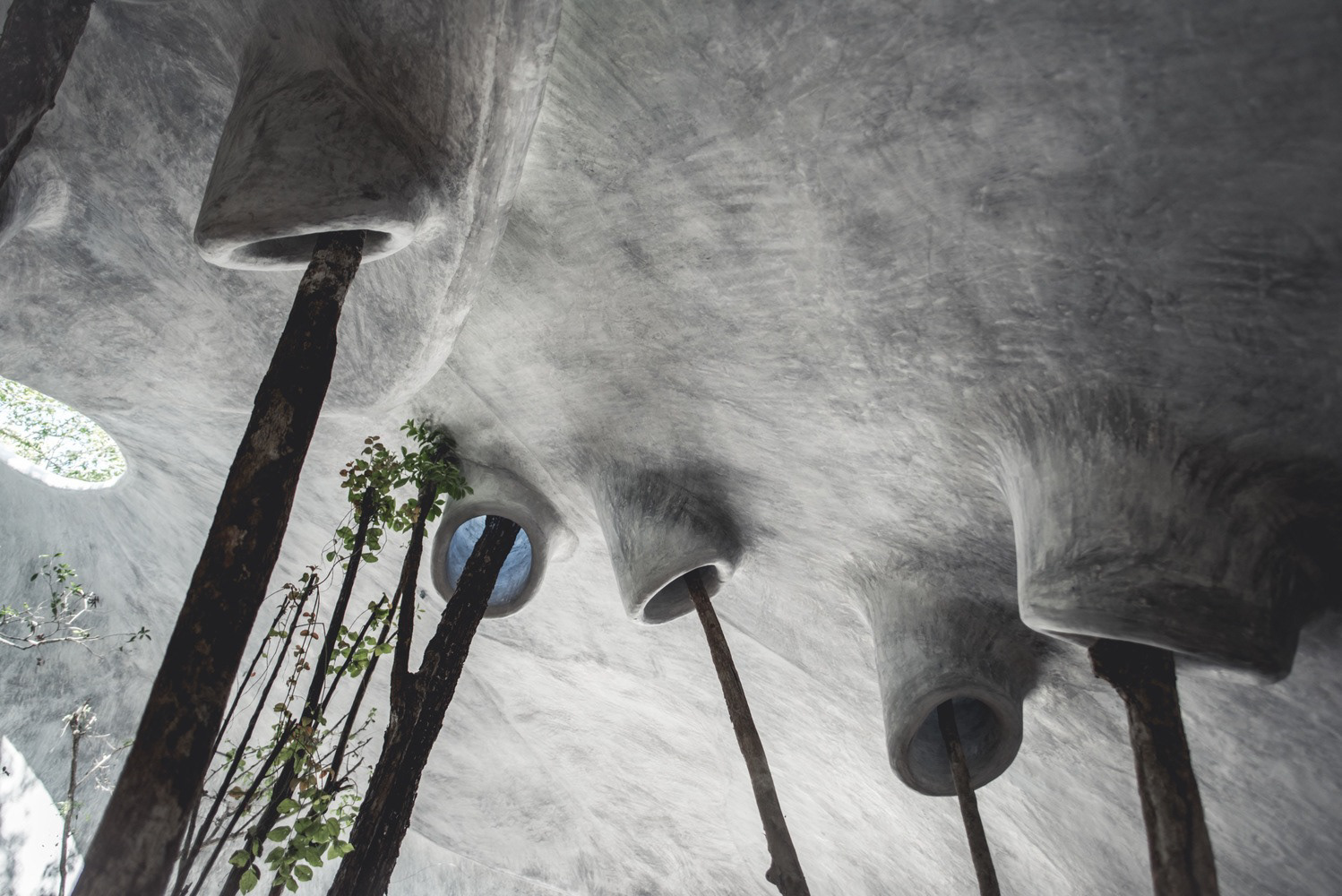







"A harmonious space to discover and develop the creative self within allowing natural, aesthetic, and ancestral wisdom to be the guide. Handmade artisanal creation enables us to reconnect, linking the creative mind and the physical world, thus allowing us to explore its endless possibilities." - Quote from the Roth Architecture website [how to reference?]
In April 2022, I visited the Azulik Francisco UH May Arts Center and spent a total of three hours immersed in its organic wonders and materiality play within the Mayan Jungle of Tulum, Mexico, located approximately an hour away from the Tulum center. Its remote setting establishes the tone for an exclusive and immersive journey through the curved structures that frame nature and light. The art center seamlessly integrates art, nature, technology, and the ancestral wisdom of the region to coexist harmoniously with nature. Azulik was designed by Roth Architecture, a firm founded by Eduardo "Roth" Neira, a self-taught Mexican-based architect known for following the "geometry of nature" (source: https://www.stirworld.com/inspire-people-eduardo-roth-neira-on-the-inherently-natural-genesis-of-his-architecture). My fascination with their studio dates back to around 2021, particularly because the Azulik location in Tulum is renowned as an elite travel destination. Roth's designs explore themes such as 'spirituality' and ethereal space, with nature at the center.
Throughout my professional experience, I've encountered limited instances of organic and irregular architecture. In the business realm, architecture often becomes diplomatic and rigid, shifting from an environmental-driven approach to one focused on monetary gain. As a result, situated in the northern hemisphere, I began searching for new examples of buildings that were innovative and inspired a built environment looking towards the future with nature as its central driver. This search led me to Roth Architecture.
To delve into Azulik, it is crucial to understand the materials Roth Studio employs to define space: concrete, steel, and glass. There are rumors that the grandson of Frank Gehry is part of the Roth Architecture studio, inspiring forms similarly to how Frank Gehry designed—with "unusual shapes and forms made with everyday materials" (source: https://www.biography.com/artist/frank-gehry).
Materiality:
"The raw materials for producing cement are common in Mexico, as they are in many parts of the world, and an important cement-producing industry has developed. Imports of cement to Mexico are negligible, while it constitutes an important export item" (source: http://www.cemnet.co.uk, web page. 30 Aug. 2000). Mexico is renowned for concrete production, treating concrete as if it were clay or playdough. In Azulik, they explore concrete as an undulating material from floor to ceiling, finishing it off with a locally sourced wood called 'Bejuco'—a vine-like wood that behaves similarly to bamboo.
Another distinctive material extensively used is fiberglass. Fiberglass is a fiber-reinforced fabric that is either "flattened into a sheet called a chopped strand mat or woven into glass cloth." In comparison to carbon fiber, it is a more cost-effective and flexible option. This flexibility is a standout feature in Roth Architecture, where they manipulate glass to imitate a reinforced fabric cloth, transcending the confines of conventional glass concepts and mathematical precision. The unique characteristic of fiberglass lies in its ability to be tinted, faded, or altered in color. While it typically comes in a base color of brown, reminiscent of the epoxy used in crafting surfboards, the potential to transform its appearance adds a layer of versatility to its application in architectural design.
Space:
The architecture of the arts center is exceptionally intricate. Visitors enter through a tunnel guiding them along an elevated path beneath tree canopies, culminating at an irregularly shaped front door. Beyond this entrance lies the primary exhibition space, a network of interconnected smaller spaces traversed by floating bridges that serve as pathways, creating an immersive experience reminiscent of an elaborate adult-scaled treehouse. This marks the commencement of a journey of exploration and play.
"We believe that creativity and human curiosity are the tools that will give us the possibility to evolve and remain in the world sustainably. From curiosity, we ask ourselves questions: a gaze without judgment and without fear that seeks answers in creativity" (https://www.sferik.art/manifethos).
The journey through the diverse exhibition spaces, despite the absence of explicit wall divisions, achieves privacy through variations in light, seating arrangements, and changes in floor materials. Abundant seating is strategically placed throughout, offering opportunities for visitors to pause and reflect on the profound impact of the space. Each seat frames a unique aspect of the environment, whether it be a tree, a light well, or a view of other individuals moving through the space – none of these perspectives are ever the same. Traversing this art center undeniably provides one of the most therapeutic experiences, blending the intuition of form and the intentional creation of space.
Walls seamlessly transition into floors and eventually seats, eliminating any straight lines from view. The design celebrates trees as the metamorphous structure harmoniously integrates with the natural landscape, blurring the boundaries between indoors and outdoors. The "roof" consists of molded fiberglass (how to reference definition below??1), following the organic form of the structure. In select areas, it opens up to allow natural light into the space, nourishing the environment. The tinted fiberglass subtly contains the soft light within, contributing to the alchemical experience of the symbiosis between humanity and nature.
The bridges gracefully lead you into and out of the building, and on certain sections of the exterior bridges, tree hammocks are strategically placed, allowing one to feel suspended in the air above the trees. This design encourages profound moments of pause, providing an opportunity to savor the landscape. The architecture cleverly facilitates a fresh perspective for enjoying the scenery.
Sensory exploration :
Upon entering, visitors are greeted with a ritual: the removal of shoes, immersing them in the refreshing coolness of the concrete floors—a welcome contrast to the humid jungle air. The tactile experience oscillates between the cool concrete and the comforting wood vines, a sensation felt on floors, walls, seats, and the connecting bridges. Periodically cushions are placed in rest areas to encourage further interaction with the cool concrete or wood vines. Outdoor areas, with connecting bridges featuring hammocks, introduce concrete as a thermal layer although the heat transfer on sunny days limits barefoot exploration.
The tree canopies offer a moment to savor the breeze above the trees, while the slightly air-conditioned yet exposed center maintains a tropical temperature suitable for both nature and visitors.
The scent is a blend of jungle aromas with intermittent smoky incense, burned as a ritual, cleansing and infusing the space with a grounding, intense fragrance that melds seamlessly with the jungle's comfortable humidity.
Sound is hushed, prompting whispers and a reverence for the journey undertaken. This silence enhances the healing exploration of spaces, encouraging self-reflection during moments of repose. In the company of my two friends, conversation was sparse until we reached the restaurant, making the emergence feel akin to a spa day.
The journey concludes with an invitation to the restaurant, engaging the final sense—taste. To complement our incredible experience, we opted for cocktails described as "in harmony with your soul. All of them are prepared based on artisanal spirits, superfoods, medicinal plants, and natural juices" -(https://www.azulik.com/gastronomy/jungle-cuisine-by-azulik). This culinary connection serves as the final link between body, spirit, and nature.
Price:
What a truly magnificent spectacle I've depicted, yet let's delve into the financial aspects. Given its approximately one-hour distance from Tulum, the taxi fare amounts to around 60 dollars for a round trip. Despite the remote location, we found it necessary for the driver to stay the entire time, ensuring the convenience of having a reliable return service from such a considerable distance—a mutually beneficial arrangement for both parties. The entrance fee proves to be fairly affordable, standing at 20 dollars per person. However, the most substantial expenses were incurred in the mixology cocktails, which averaged around 40 dollars each—a rather steep price point. Despite this, after undergoing such a therapeutic journey, immediate concerns about money take a back seat to the desire to celebrate the experience.
Azulik Uh May isn't their only architectural masterpiece in Tulum; it indeed boasts the Azulik Resort, the Azulik Exhibition Space, and the Kin Toh restaurant, all interconnected along the beachfront. All these projects adhere to eco-friendly practices, exclusively using locally sourced elements such as soaps. Notably, there are no plug points to reduce energy usage, and the absence of showers and the inclusion of shallow baths serve to limit water wastage.
Despite these sustainable practices, the hotel rooms are on the pricier side, averaging between 600 to over 1000 dollars per night per person—a cost that may seem steep, particularly for the region of Mexico and its peso currency. However, this juxtaposition underscores the delicate balance required when exploring the intricate forms and wonders of conceptual architecture.
In conclusion, Azulik represents not only a marvel but a novel approach to the built environment. Expressing what they've accomplished proves challenging, as they've captured something truly unique. I advocate for the integration of these themes and architectural approaches into the collective consciousness of the built environment. There is a profound necessity in designing and constructing in a manner that preserves the connection between humanity and nature.
